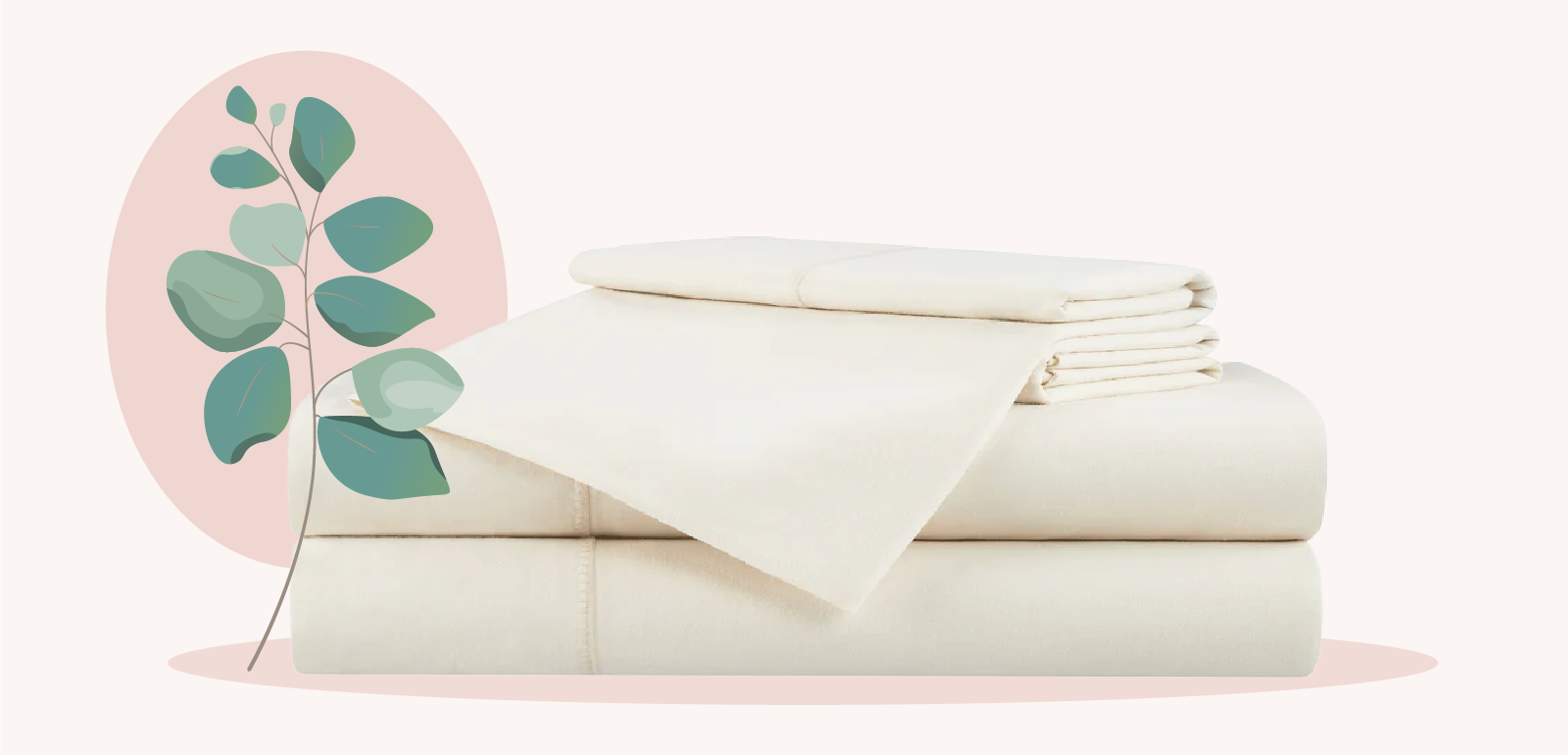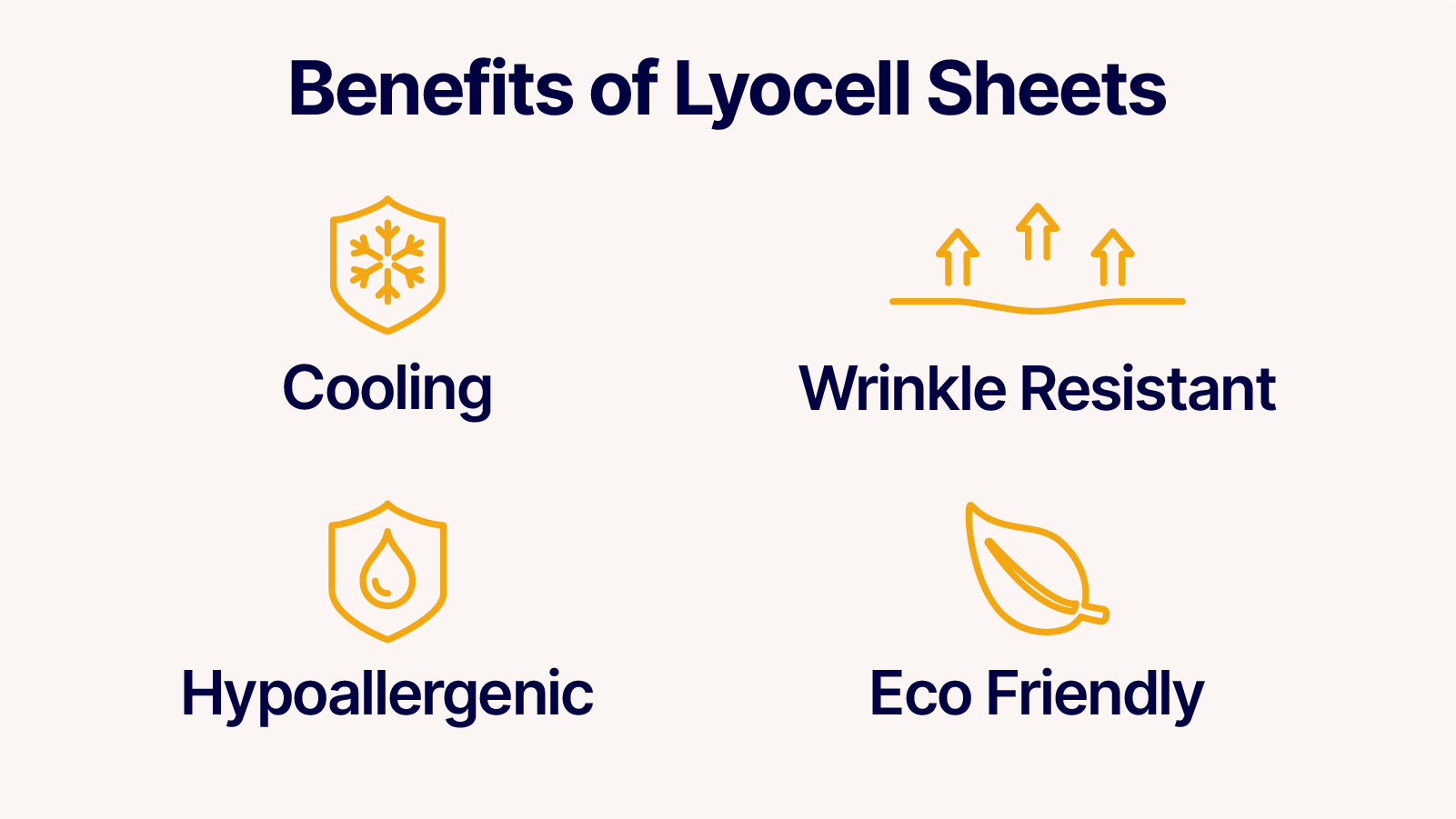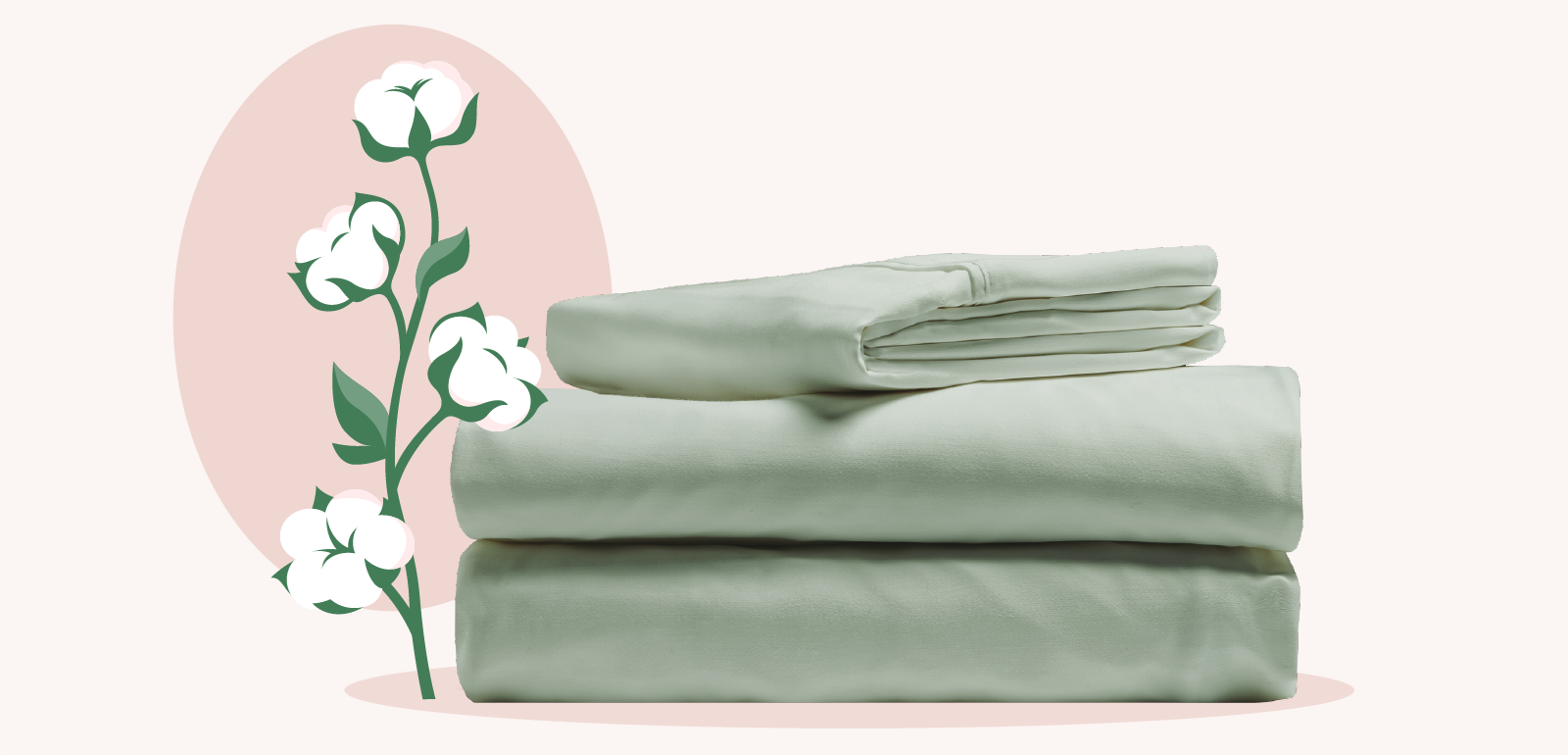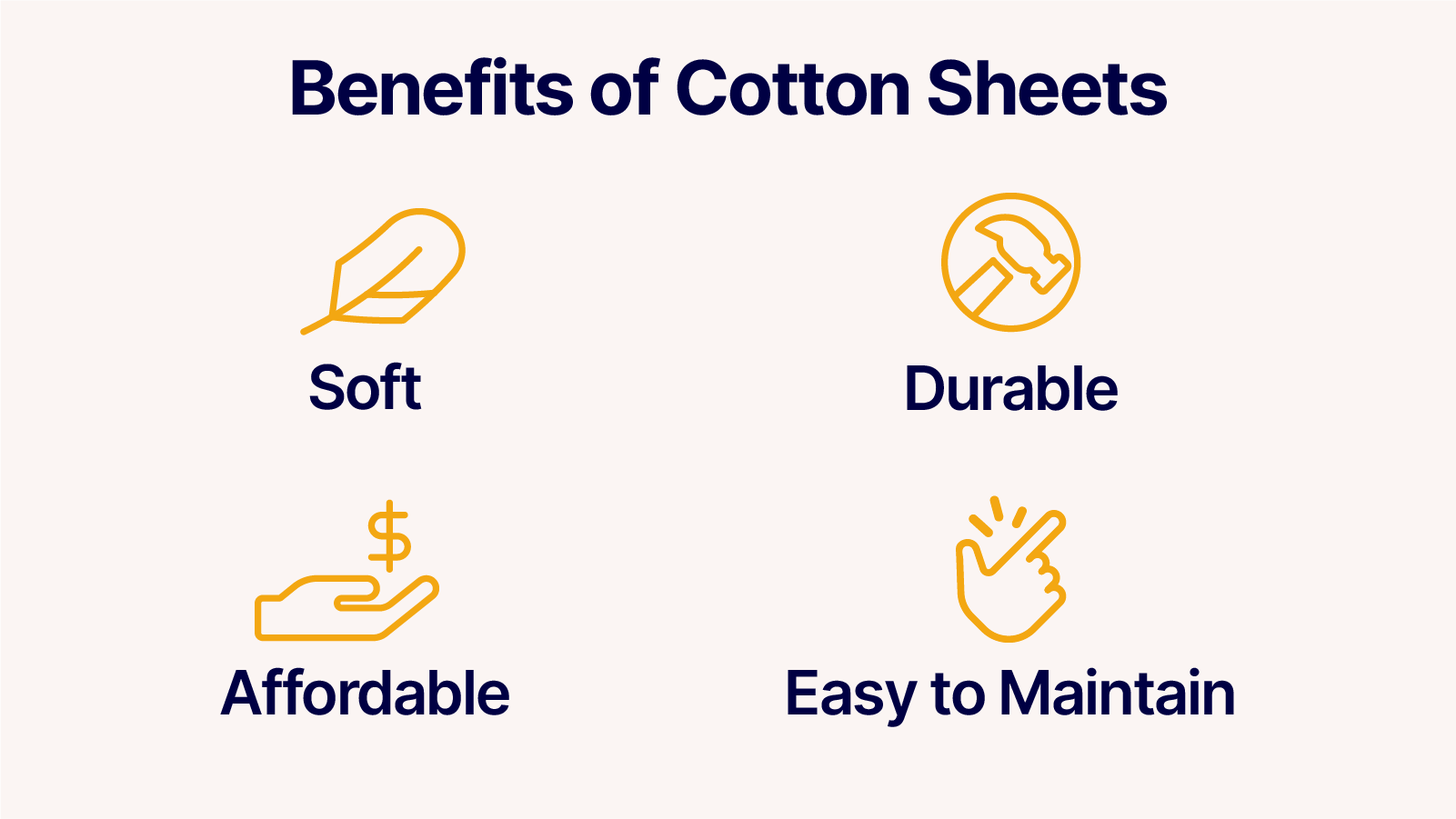Lyocell vs Cotton Sheets (2025)
Updated: December 9, 2025 | Published: July 2, 2024After months of research and careful deliberation, you’ve finally found the perfect mattress. But now comes the next important choice: selecting the ideal set of sheets. Choosing between Lyocell and cotton sheets is no easy task.
Cotton is a popular choice for many sleepers. It comes in a variety of options, is breathable, and is affordable. On the other hand, Lyocell sheets provide a silky, smooth, and cooling feel. Although ultra-breathable and eco-friendly, they can be more expensive than cotton.
In this guide, we’ll dive into the specifics and break down the differences between Lyocell and cotton sheets. We’ll help you find the right fit to complement your mattress and improve your sleep experience.
Breakdown: Lyocell vs. Cotton Sheets
Factor | Lyocell | Cotton |
|---|---|---|
Cost | $100–200+ | $50–200+ |
Appearance | Smooth, shiny finish; wrinkle-resistant | Smooth, matte, or shiny finish; certain weaves are prone to wrinkling |
Durability | Long-lasting with proper care | Long-lasting with proper care |
Machine Washable | Yes, but requires special care and may shrink in the dryer | Yes, but may shrink in the dryer |
Feel | Soft and silky | Soft, breathable feel |
Variety | Plain, twill, crepe, and more | Sateen, percale, flannel, twill, jersey, and more |
Temperature | Wicks moisture for a cool and dry sleep | Regulates temperature well |
Sustainability | Known for its sustainable, closed-loop production process | Uses more water to produce |
Best for… | People wanting soft, sustainable sheets with less focus on price | People wanting versatile, breathable sheets at a lower price |

What Is Lyocell?
Lyocell is commonly known by the brand name Tencel (trademarked by Lenzing AG in 1982). It’s a plant-based, semi-synthetic fibre used in clothing, bed sheets, and other items.
Typically made from eucalyptus, birch, or bamboo, Lyocell is usually produced through a sustainable, closed-loop process that minimizes or eliminates pollution and runoff during manufacturing.
The manufacturing process involves soaking and dissolving the wood from these trees in a non-toxic solution, turning it into pulp, and spinning the pulp into fibre. These long fibres give Lyocell its smooth feel.
Lyocell is more absorbent than cotton and draws moisture away from your body for a cooler, airier sleep. While they require extra care, you don’t need to wash them as often due to their antibacterial properties. It’s even possible to damage Lyocell sheets by overwashing them.
READ MORE: How often should you wash your sheets?
Lyocell sheets could be a good fit if you’re willing to spend a bit more time laundering them and if you’re fine to splurge on hypoallergenic sheets with a smooth, cool feel.
Benefits of Lyocell Sheets
- Cooling properties keep the sheets comfortable, even if you’re a hot sleeper
- Wrinkle resistant for easier maintenance and an attractive look
- Hypoallergenic to ensure comfort for sensitive skin
- Eco-conscious manufacturing so you can feel good about your bedding

Drawbacks of Lyocell Sheets
- More expensive than other types of sheets
- Needs special care and maintenance
- Can shrink or be discoloured if exposed to high temperatures
- Can’t be used with bleach or fabric softener
- Fewer weave options than other types of sheets

What Is Cotton?
Cotton plants produce fibres used to create a material that’s popular for its versatility and comfort. However, cotton requires lots of water, space, and time to grow, making it less environmentally friendly than Lyocell. That said, organic cotton is becoming more accessible as a green alternative.
Cotton is very versatile and comes in a variety of weaves, like Sateen, Percale, Jersey, Flannel, and Twill. Short staple cotton, such as Upland cotton, is less smooth and has a crisp feel. It is typically used in less expensive sheets and garments.
Cotton sheets, such as Pima and Egyptian cotton sheets, have extra-long fibres, producing a smooth, silky, and luxurious material. The type of weave you choose will vary depending on your budget and how you want the sheets to feel against your body.
Benefits of Cotton Sheets
- Soft and silky feel that’s enjoyable for many sleepers
- Durable and easy to care for
- Affordable compared to many other types of sheets
- Easy to maintain because they’re machine washable

Drawbacks of Cotton Sheets
- Only certain weaves will be wrinkle-free
- Manufacturing process isn’t as eco-friendly as Lyocell
- Typically feel less cool compared to Lyocell
- Can shrink when exposed to high temperatures
Which Is Better: Lyocell Sheets vs Cotton Sheets?
Both fabrics have their own pros and cons. In the end, it all comes down to preference. Use this table to pick the best bed sheets for your needs:
Choose Lyocell sheets if… | Choose cotton sheets if… |
|---|---|
|
|
READ MORE: What’s the best material for bed sheets?
FAQ
How do you wash Lyocell sheets?
Lyocell sheets need more specific care and maintenance compared to sheets made of cotton. Either hand-wash your Lyocell sheets, or wash them alone in your washing machine at a lower temperature on a gentle cycle.
If you have it, use biodegradable detergent to avoid any damage. You can also hang your sheets to dry, or tumble dry on low, to avoid shrinking or discoloration from high heat.
Because of their antibacterial and moisture-wicking properties, Lyocell sheets shouldn’t need to be washed as often as cotton sheets. Instead, you can hang them outside on a nice day to freshen them up.
How do you wash cotton sheets?
Every two weeks, place your sheets in the laundry machine with your favourite detergent, and wash them in warm water. Tumble dry on medium or low, as high heat could shrink your sheets.
Your new cotton sheets might start out a bit stiff, but don’t worry—they should get softer with each wash.
What’s the difference between Lyocell and bamboo?
Lyocell and bamboo are similar in nature. They’re both known for being cooling, antibacterial, hypoallergenic, moisture-wicking, environmentally conscious, and smooth to the touch.
What makes these sheets slightly different is the way they’re manufactured. Bamboo sheets are made with existing bamboo fibres, while Lyocell uses a process that spins wood pulp into fibres.
Both the bamboo and Lyocell processes are considered eco-friendly because of their closed-loop nature. There is little to no product runoff or pollution during manufacturing.
Lyocell can sometimes be a pricey option. Bamboo sheets are a good alternative to get all of Lyocell‘s benefits at a lower cost.
What’s the difference between cotton and bamboo?
Cotton sheets are ideal for those who want a low-maintenance, breathable, and affordable bedding option. They are known for their versatility and comfort, making them a reliable choice for many sleepers.
Bamboo sheets are often praised for their cooling properties and smooth and silky feel. They offer a luxurious sleeping experience and are perfect for those who prioritize eco-friendly products and enjoy a cooler sleep environment.
Both bamboo and cotton sheets have unique advantages, so consider what qualities you value most in your bedding.
READ MORE: How do cotton sheets compare to linen sheets?
Shop Bamboo Sheets Shop Cotton Sheets
Our goal is to provide the information you need to find the mattress that’s right for you. Get started with some of our most popular mattress shopping resources:
- Best Mattress Guides: Best Mattress Canada, Best Mattress In a Box
- Reviews: Douglas Original, Logan & Cove Choice, Juno, Octave Vista
- Comparisons: Douglas vs Endy, Douglas vs Casper
We use independent, third-party engineering firms (commissioned by us) with the APEGA stamp of approval to conduct mattress testing on our behalf, using publicly available data. We review and test all mattresses on 40+ criteria we think are important to you, including price, country of manufacture, sleep trial, warranty, features, materials used, motion isolation and edge support ratings, customer satisfaction reviews, returns, and refunds.
